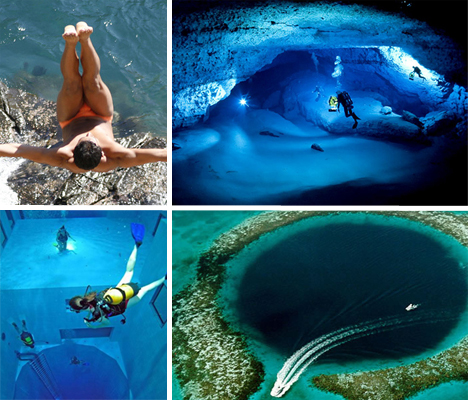
For some adrenaline junkies, there’s just nothing more exhilarating than diving – whether underwater in a dark, complex system of caves or into a lake from a towering cliff. Divers relish the thrill of exploring places that most people don’t get to see, and some risk their lives to travel to depths of up to 400 feet. Many haven’t made it out of these incredibly deep and dangerous dive sites alive.
Valhalla Missile Silo, Texas
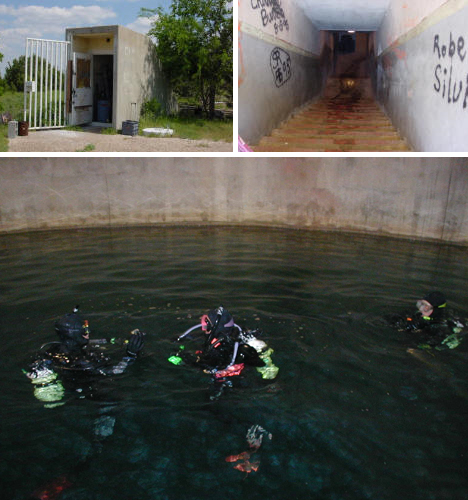
(images via: Family Scuba)
Just outside Abilene, Texas is a nuclear missile silo where adventurous divers descend a rather frightening-looking set of stairs and brave water temperatures as cold as 57 degrees Fahrenheit. The facility was once used to house nuclear-tipped Atlas missiles, and after the U.S. government abandoned it, it was purchased and converted into a controlled-environment training facility for technical diving. The silo is 60 feet in diameter and the water is 130 feet deep.
Nemo 33, World Deepest Diving Pool
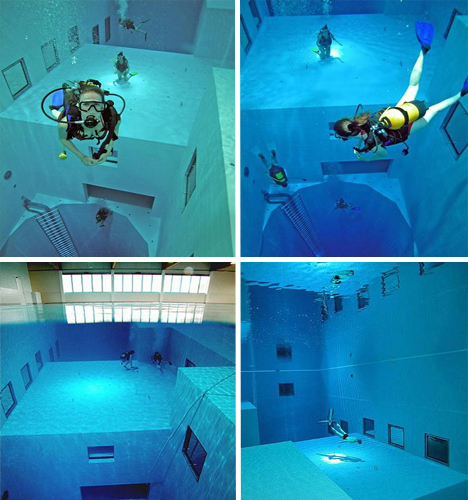
(images via: toxel)
The world’s deepest diving pool is a recreational scuba center in Uccle, Belgium called ‘Nemo 33’. The pool is a giant submerged structure with flat platforms at varying depth levels, with two flat-bottomed areas at 16 feet and 32 feet. A large circular pit descends to a depth of 108 feet. It’s filled with non-chlorinated, highly filtered spring water and contains a few simulated underwater caves. Visitors can watch the divers from windows on the sides of the pools. The facility was designed for diving instruction, recreation and film production.
Blue Hole at Lighthouse Reef, Belize
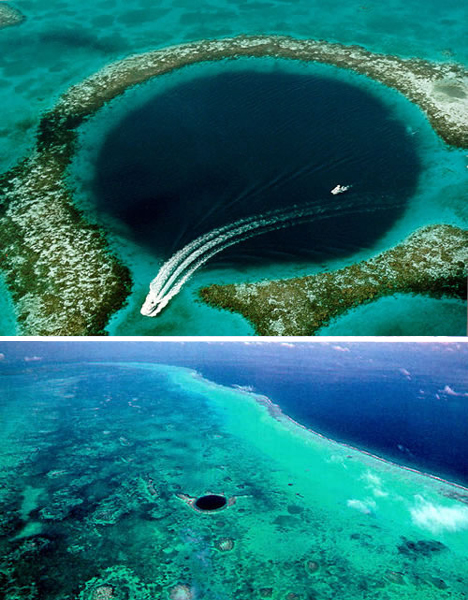
(images via: C & M D)
1,000 feet in diameter, the Belize Blue Hole is a perfectly circular pool of inky darkness, like a portal into the bizarre world of deep-sea life. Located about 60 miles from Belize City, the Blue Hole is 480 feet deep with the outer edge just a few feet underwater at high tide. It’s the result of repeated collapses of a limestone cave system formed during the last ice age. The walls surrounding the motionless column of water are sheer until a depth of 110 feet, when divers encounter stalactite formations. It’s one of the most popular and famous diving sites in the world.
Cliff Diving at Wolfgangsee, Austria
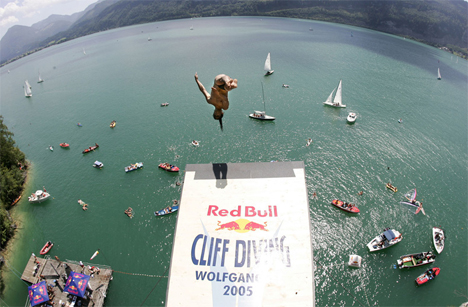
(images via: Wildcard Photodesign)
The annual Red Bull Cliff Diving Event happens every July on Lake Wolfgang in Austria, drawing thousands of visitors who watch as experienced divers make death-defying jumps from staggering heights. 27.5 meters separate the takeoff board from the surface of the water, and as each diver plunges downward, he accelerates from zero to 90 kilometers per hour in just 2.5 seconds and decelerates to zero just four meters after entering the water. It’s an extremely dangerous sport that requires total body control and concentration to pull off. As diver Niki Stajkovic observed, “You might survive a minor mistake when you jump from a tower, but not when you dive off a cliff.”
Cenote Esqueleto Temple of Doom, Mexico
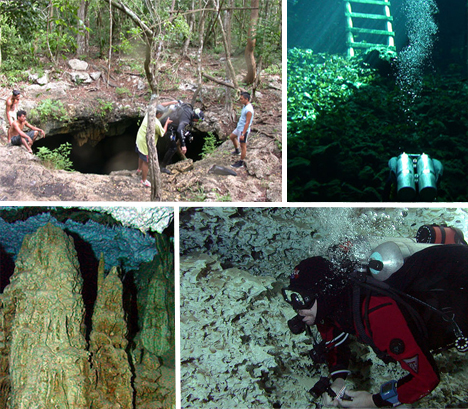
(images via: gerb)
Just outside of Tulum, Mexico is Cenote Esqueleto, known rather ominously as the ‘Temple of Doom’. It’s difficult to reach, and there’s no ladder, so you’ll have to just jump in. Entering the cavern is said to be uncomfortable due to the mix of salt and fresh water. It’s a 25-foot-diameter hole with a large undercut ledge. Divers are advised to stay within the daylight area, because it’s all too easy to get lost in the dark cave system.
Devil’s Cave System in Ginnie Springs, Florida
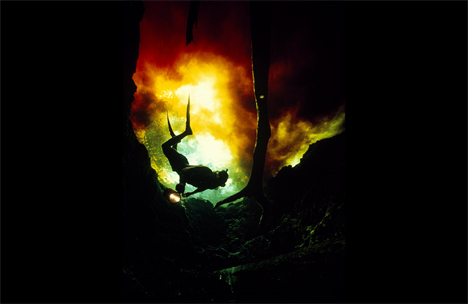
(images via: National Geographic)
Little Devil, Devil’s Eye and Devil’s Ear in Ginnie Springs, Florida offer three very different cave diving experiences in a year-round water temperature of about 72 degrees Fahrenheit. The currents are strong and at the Devil’s Ear, divers must take extra care because of the narrow vortex opening which can cause their gear to shift around.
Diepolder II Cave, Florida
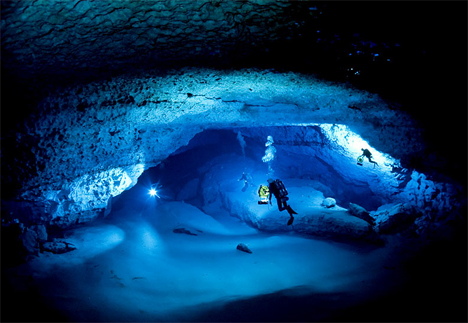
(images via: National Geographic)
What looks like a nondescript pond from above the surface is a stunning underwater cavern that reaches 360 feet into the ground – the deepest cave in the continental U.S. Named after the man who originally owned the land, the Diepolder II cave has a sister cave called the Diepolder III that, at 300 feet, is not quite as deep but still impressive. Both are located on the Sand Hill Boy Scout Reservation near Brooksville, Florida, and can only be seen on guided tours.
Dahab, Egypt Blue Hole
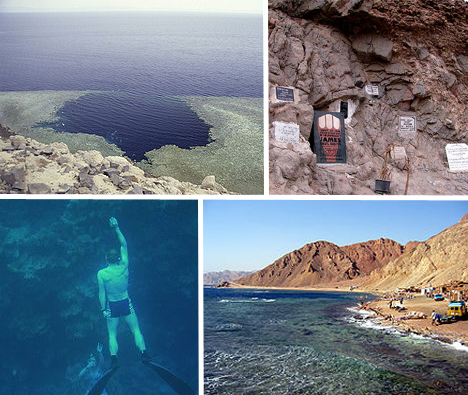
(images via: Wikimedia Commons)
On the East Sinai Peninsula in Egypt on the coast of the Red Sea is The Blue Hole, a submarine pothole that reaches over 426 feet into the depths of the earth. It’s best known for the astonishing number of diving fatalities that have occurred there, having been deemed “The World’s Most Dangerous Diving Site” and earned the nickname of “Diver’s Cemetery”. Inexperienced or overconfident divers sometimes have trouble finding the tunnel connecting the Blue Hole and open water and end up descending too deep.
Deep sea divers who attempt to dive the blue hole often use a mix of gases called trimix to handle the depth of the dive, as well as multiple air tanks. Regardless of preparation at some point nitrogen narcosis kicks in (approximately 53m) – making the diver feel "high" and impairing judgment. Those who dive at this spot often stumble upon old wet suits and gas tanks from divers who never made it out of The Blue Hole. One such diver, Yuri Lipski, famously brought his camera down in to the Blue Hole where he lost consciousness after 5 minutes and failed to surface. The video, now posted on Youtube has garnered over 8 million views. Over 100 divers have lost their life to The Blue Hole.
Eagle’s Nest Sinkhole
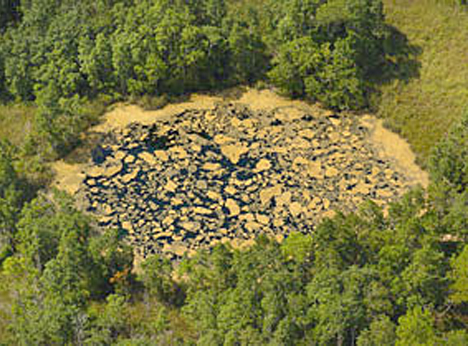
(images via: St. Petersburg Times)
In another case of a very unimpressive, scummy-looking pond hiding wondrous depths, the Eagle’s Nest Sinkhole in Florida has chambers as large as gymnasiums and crystal-clear water. It contains a mile of marked passages and is up to 300 feet deep in some areas. Even experienced divers have died here – six since 1989. Extreme care must be taken to descend and ascend very slowly. Called “one of the Mount Everests of cave diving”, the Eagle’s Nest is definitely not for beginners.
La Quebrada Cliff Diving in Acapulco, Mexico
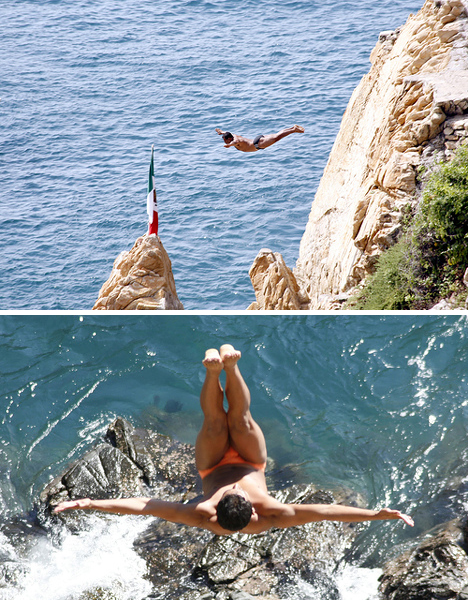
(images via: digipixbycm.com)
Copycats beware – the La Quebrada cliff divers are highly trained professionals that have made cliff diving into an art form through daily performances in Acapulco, Mexico. They plummet up into the ocean from up to 147 feet in the air and must time their dives with the waves below to avoid crashing into the rocks. Even more impressive, they dive at night holding torches. Nothing like hurtling yourself off a cliff into a shallow, rocky sea with fire in your hand.
Samaesan Hole, Thailand
Similar to Valhalla Missile Silo, the Samaesan Hole in Thailand is a 90-meter-deep former military ammunitions dump. Technical divers come here to practice on trimix. It’s called an ‘explosive dump ground’ on marine charts because it contains unexploded bombs. Ballsy divers have to bring multiple lights since sunlight doesn’t penetrate the depths, and the currents are extremely strong. It’s said to be fascinating but unfortunately, no one seems to have taken any photos.
Black Hole of Andros, Bahamas
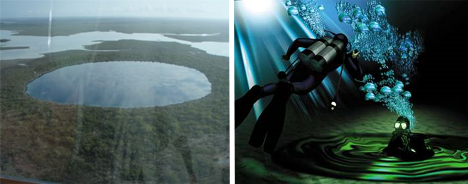
(images via: EarthEco, Divernet)
Diver Steffi Schwabe descended into the depths of the Black Hole of Andros and lived to tell the tale, but even the most adventurous of divers won’t be able to replicate her experience because the Black Hole is open for scientific exploration only. The conditions inside replicate those of oceans billions of years ago when they were unable to support much life. Schwabe’s eerie account of what it was like to pass through layer after layer of hot, dangerous hydrogen sulfide and Technicolor mud that felt like jelly is bizarre and fascinating.
More:






